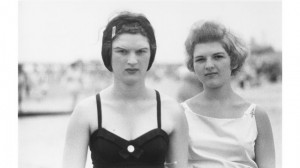The story of photographer Diane Arbus (1923-1971) is a familiar one in the medium’s 20th century history. Born and raised in New York City, Arbus started photographing in the mid-1950s and soon came to the attention of Alexey Brodovitch, the influential art director at Harper’s Bazaar and John Szarkowski, the formidable curator of photography at New York’s Museum of Modern Art, whose support was central to her early and sustained success. And there are the sad details, specifically Arbus’ suicide at age 48, and with it the end of a promising career. These things we know, all informed by an institutional narrative shaped almost exclusively by exhibitions and publications over the course of 42 years. To this well-tread ground comes the latest exhibition, Diane Arbus 1971-1956, which posits that the artist’s technical and aesthetic evolution can be seen both in singular images and in the groupings in which they are presented.
The exhibition is organized by two schemas. The first is chronological, one image each representing the years 1956 through 1971, the respective beginning and end of Arbus’ career. Only the chronology is reversed, as the exhibition title suggests. The backward pass through Arbus’ work is informative. In the later, more accomplished prints, we see her technical skill as it stood at the preempted height of her career. In earlier pieces, our attention is drawn to smaller print sizes and the choice of sitters — interracial couples, nudists, circus performers, transvestites — the so-called freaks that defied rigid, mid-century mores who haunt and became a hallmark of her work. Many of the exhibited images were included in the 2003 retrospective mounted by SFMOMA, others are less familiar, and the curatorial decision to visualize ideas of Arbus’ creative evolution via non-iconic imagery is a smart one.

Diane Arbus, Two ladies at the automat, N.Y.C. 1966;c. The Estate of Diane Arbus

Kid in black-face with friend, N.Y.C. 1957;c. The Estate of Diane Arbus
The second organizational strategy marshals groups of images under five categorical headings, purportedly drawn from the artist’s and other writings that address her work. Illustrating at times vague titles such as “Recognition,” “People Being Somebody” and “Winner and Losers,” the groupings of photographs visualize Arbus’ interest in the singular human being engaged in the performance of self, and how those who fell so far from enforced social norms existed despite often vocal public scorn.


